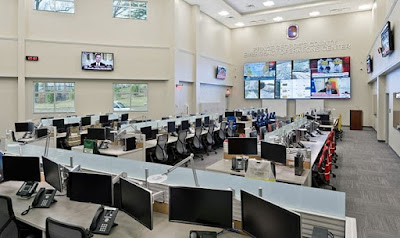The Importance of Interoperability
As mentioned above, Emergency Operations Centres often have multiple teams, each focused on solving specific tasks, each with their own sources of information and work tools. It is, therefore, important that these teams can instantly share information with the other teams and share the information sources with the main video wall for collaborative viewing.
This experience needs to be easy and seamless for the staff, and the only way to ensure that is to deploy interoperable technology that can easily integrate with the various tools used in different areas of the facility. This is where the need for effective video wall processing and collaboration technology comes into play, enabling users to easily view and interact with audiovisual sources and collaborate between different work areas. Whether working with the primary video wall, a secondary display, a desktop, or a display in a meeting room, the technology behind the scenes must be able to seamlessly handle (or route) sources and data from any source to any display throughout the EOC.
Manufacturers are making huge investments in developing unified visualization solutions to make their platforms interoperable and as intuitive as possible. Their objective is to provide users tools that are easy to use, quick to learn, but are also extremely flexibile and efficient. Click here to learn more about unified visualization.
EOC’s also need a robust solution to distribute source signals across all the displays in the facility with very low latency. More and more organizations are turning to next-generation AV-over-IP solutions to facilitate signal distribution to enable effective collaboration.
VuWall has been focussed on developing interoperable AV-over-IP solutions for that exact reason – to facilitate the deployment and usage of visualization systems, for the most effective distribution of visual content from any source to any display.
The Visualization Experience
When selecting a display, visual acuity is the key consideration. This is what will allow operators and decision-makers to see what they need to see, where and when they need to see it, and respond efficiently in a timely manner. It comes down to a simple equation: you have to consider the size of the display, the distance at which the information is going to be viewed, and the type of content or source that is going to be displayed.
In other words, operators must be able to properly see the big picture, but also be able to clearly read the content and interpret any symbols or alerts from their physical location in the EOC. A resolution of 1080p may be adequate in many control rooms and Emergency Operations Centres, but there are applications where 4K (8K in the near future) is already necessary to avoid losing the ability to see important details that are displayed on a large video wall.
Consider, for example, a government intelligence centre that assesses a target area and observes information from high-resolution cameras or maps. These would include visual details that are crucial for decision-making. The size, distance, resolution and ergonomics of the video wall are important factors to consider so that operators are able to interpret situations accurately and respond appropriately.








